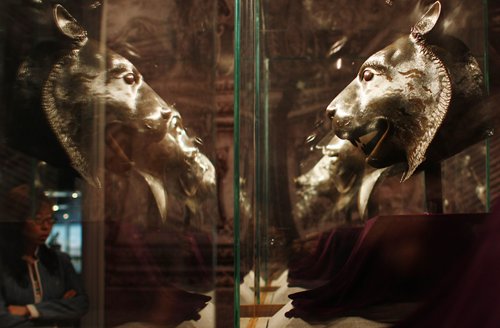
Bronze heads once belonging to sculptures of the 12 Chinese zodiac signs on display at the Poly Art Museum in Beijing in 2009 Photo: CFP
On Wednesday, China's National Cultural Heritage Administration announced a series of achievements concerning the conservation and utilization of cultural relics over the past decade, emphasizing that more than 1,800 sets of cultural relics that had been lost overseas had been returned to the motherland.
Efforts to search for and return lost cultural relics has seen some breakthroughs in recent years, making cultural relics a "golden name card" to promote exchanges between countries, administration official Jin Ruiguo said, according to a report from the China News Service.
Among the achievements, the return of the head of a bronze Chinese zodiac horse statue to its home at the Yuanmingyuan (the Old Summer Palace) in Beijing has been seen as a crucial step in bringing home important cultural relics stolen by invaders over 100 years ago. Many Chinese netizens said they view the return as a symbol of "washing away national humiliation."
The bronze horse head, which was stolen by British and French troops 160 years ago, was donated by the late Macao casino tycoon Stanley Ho to the National Museum of China on November 13, 2019 to celebrate the 70th anniversary of the founding of the People's Republic of China. Ho had bought the head for HK$69.1 million ($8.84 million) at an auction in September 2007.
Huo Zhengxin, a law professor at the China University of Political Science and Law, told the Global Times that cultural relics lost overseas return to China in four ways - through law enforcement agencies, diplomatic negotiations, purchasing or donations.
Chinese authorities have been trying to prevent the illegal trafficking of relics through different methods. For instance, the administration has launched a webpage dedicated to the international fight against the illegal trafficking of cultural property.
The webpage links to two databases, the Stolen (Lost) Cultural Relics Information Publishing Platform of China and the Stolen Foreign Cultural Relics Database, which are aimed at retrieving lost cultural property.
Jin also noted other achievements made over the past decades, including several conservation projects for significant cultural heritages such as the Great Wall and the Grand Canal.
Additionally, the modern Chinese museum system has matured, with 6,183 museums on record nationwide, among which 91 percent offer free admission. Annual exhibitions increased by 144 percent and the number of visitors increased by 119 percent comparing to a decade ago.
Capabilities to protect and promote relics are being improved through innovative means. The technical standards for ancient fresco protection, painted pottery conservation, lacquer ware protection as well as environmental monitoring and control have reached first-tier international standards.




